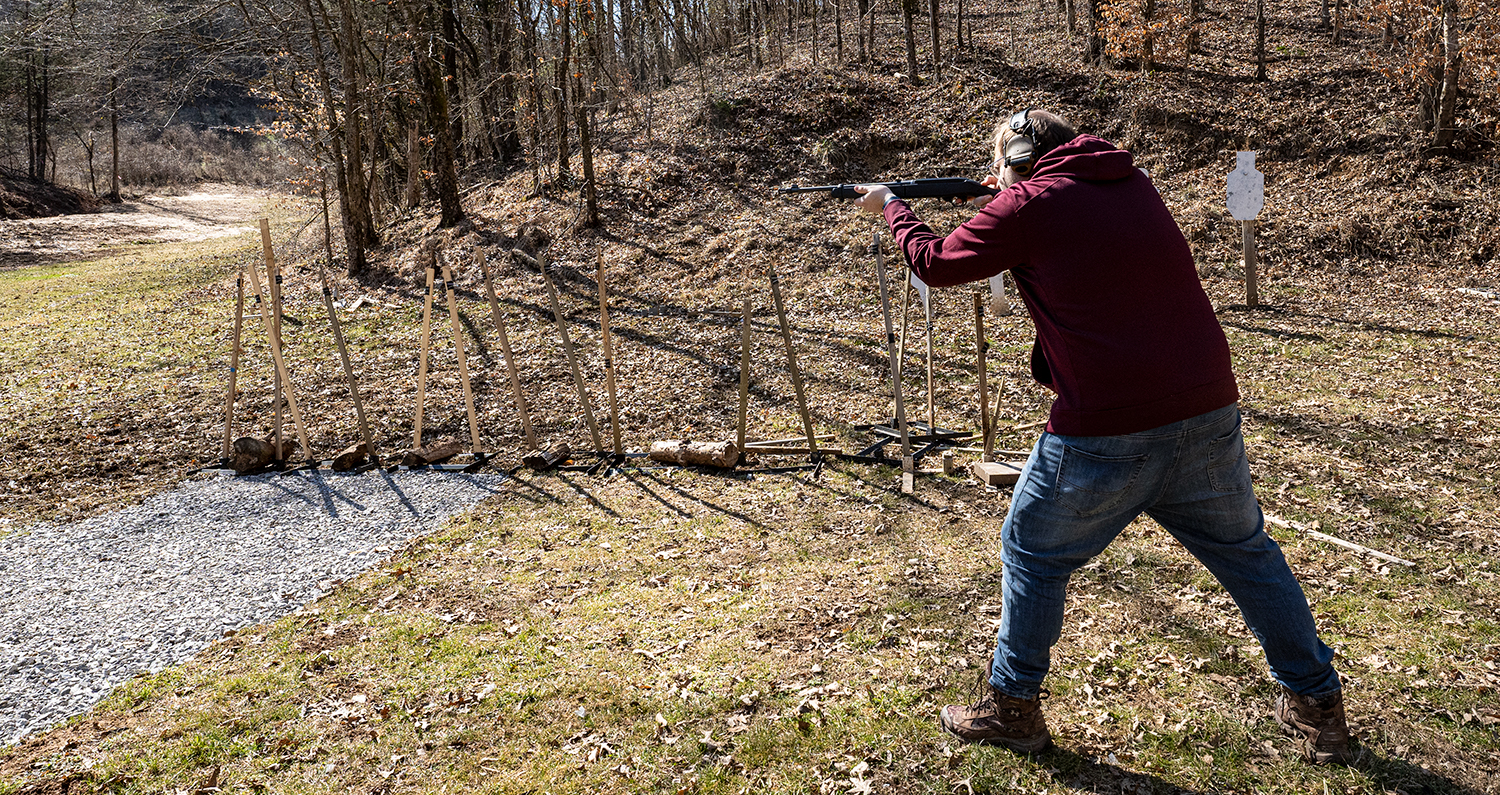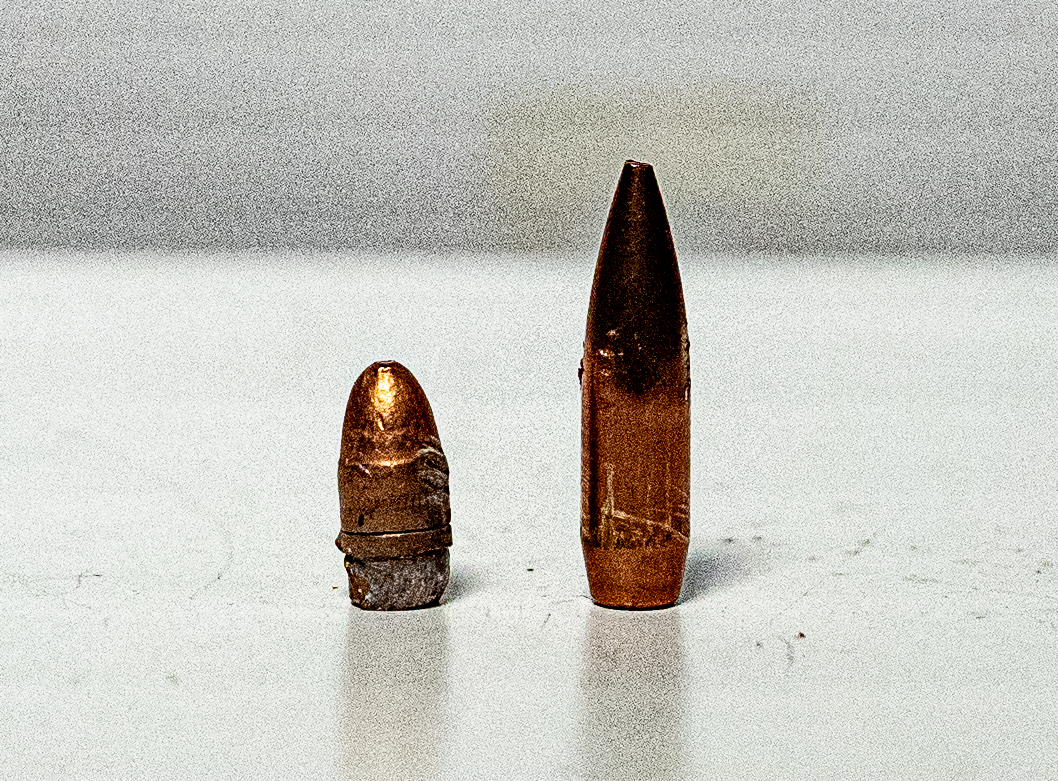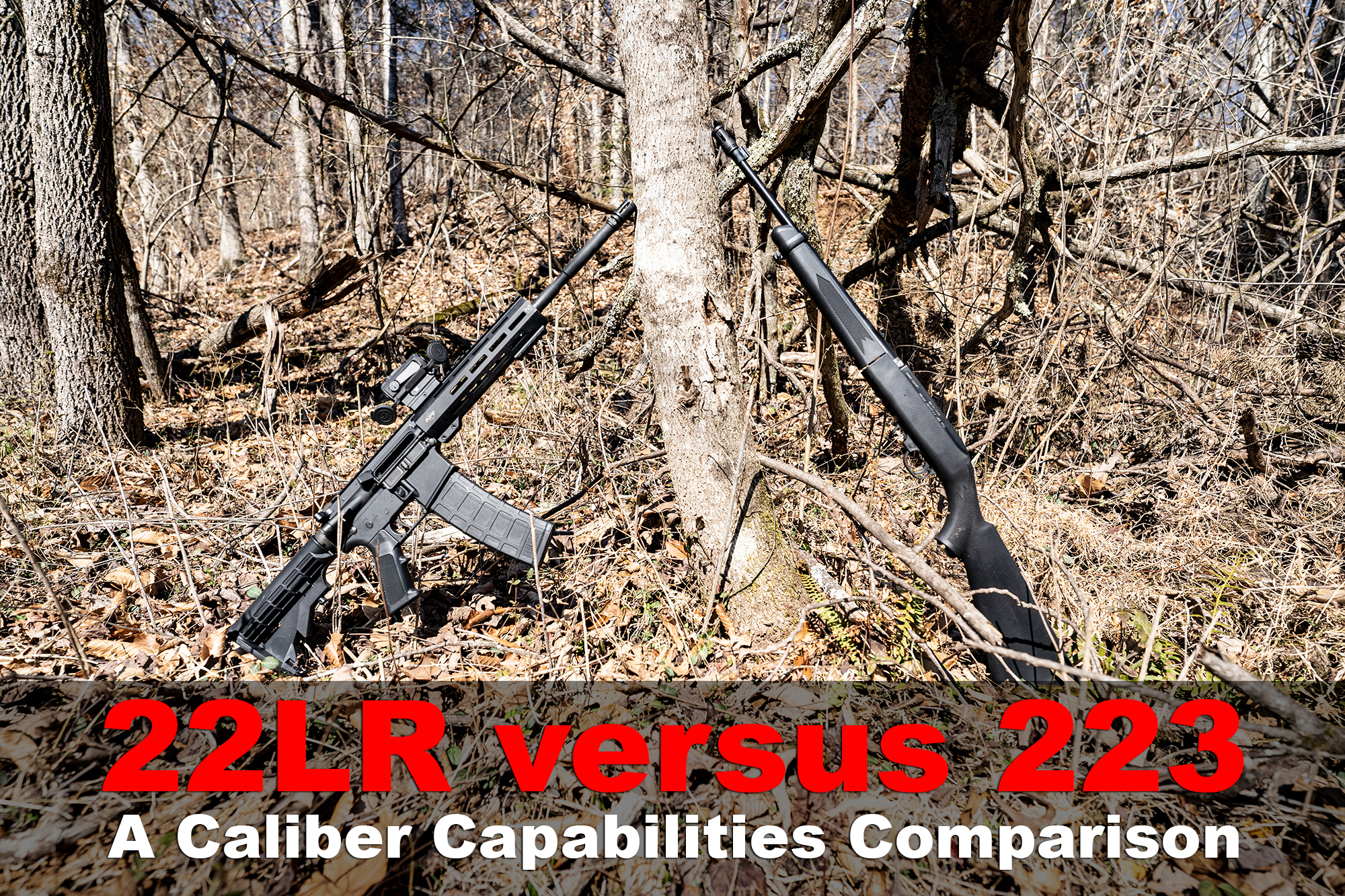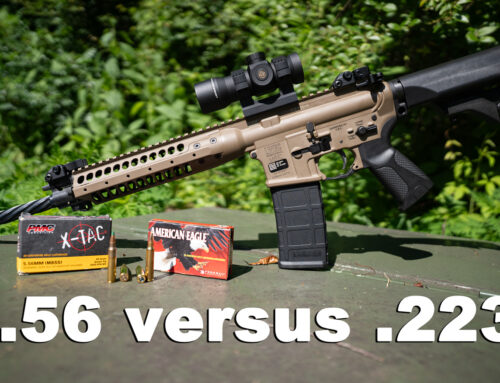If you’re remotely familiar with firearms, then we can already imagine what you’re probably thinking: “Why in the Sam Hill is this fine website wasting time comparing two such radically different rounds of ammunition?” While they both might start with “22” there isn’t a ton in common between 22LR vs 223 ammo.
But, in our defense, we would only offer that not everyone has honed as much expertise as you. Truth be told, many people who are just beginning to learn about guns ask about the difference between 22 Long Rifle vs 223 Remington. This is understandable, as the cartridges share virtually identical bullet diameters – and indeed often have the same bullet weights.
So what distinguishes the 22 LR from the 223 Rem? Power, primarily. The 223 Rem sends its bullet out of the barrel at more than three times the velocity of the 22 LR, which has dramatic implications for performance. Although both cartridges can be useful for hunting, target shooting and even self-defense, their muzzle velocities are so disparate that they’re essentially incomparable.
Let’s compare them anyway as we observe how the 22 LR and 223 Rem differ in terms of ballistics, stopping power and recoil. But first, lets see what we can learn by comparing the rounds side by side.
Cartridge Dimensions 22LR vs 223

| 22 LR | 223 Rem | |
|---|---|---|
| Parent case | 22 Long | 222 Rem |
| Case type | Rimmed, straight | Rimless, bottleneck |
| Bullet diameter | 0.223 in | 0.224 in |
| Neck diameter | 0.226 in | 0.253 in |
| Base diameter | 0.226 in | 0.376 in |
| Rim diameter | 0.278 in | 0.378 in |
| Case length | 0.613 in | 1.760 in |
| Overall length | 1.000 in | 2.260 in |
| Maximum pressure | 24,656 psi | 55,000 psi |
You’ll notice right away that the 223 Rem is the much larger cartridge. Its case and its overall length are both greater than those of the 22 LR. Its much larger case naturally holds more propellant – the stuff that explodes to propel the projectile. The 223 Rem can easily have 12 times more powder than the 22 LR!
The two rounds’ bullet diameters are in fact virtually identical, but they don’t have the exact same bullet. The 22 LR is most commonly loaded with a 40 grain bullet. (For reference, 1 grain equals 1/437.5 ounces.) The 22 LR is an economical cartridge, so its bullet is never jacketed with copper. It usually has a solid lead bullet, or one that is plated with a very thin layer of copper.
The 223 Rem, on the other hand, is most frequently loaded with a 55 grain bullet. Because the 223 Rem was conceived as a cartridge for semi-automatic rifles, its bullet is always jacketed with copper (which strengthens it enough to prevent deformation that could cause a jam during feeding).
The 22 LR has a rimfire primer. This is the patent of a relatively weak cartridge, as the case brass must be thin enough for the firing pin to make a dent deep enough to crush the primer inside. With few exceptions, rimfire-primed ammo is always weaker than Boxer-primed ammo. You’ll find no such exceptions here.
The 22 LR has a rimmed case. This helps the cartridge chamber correctly in firearms like bolt-actions, lever-actions and revolvers. Rims do complicate rapid cycling of a firearm, however. There are indeed semi-autos which can fire ammo with rimmed cases, yet cartridges that were designed specifically for semi-autos never have rims.
The 223 Rem has a bottlenecked case. Without getting too deep into the subject, a bottlenecked case helps the cartridge put more energy behind its bullet. This is not the sole reason for the 223 Rem’s higher velocity (see: more powder), but it certainly doesn’t hurt!
Ballistic Performance of 22 LR vs 223 Rem

| 22 LR - CCI 40gr LRN | 223 - Hornady TAP 60gr Polymer Tip | |
|---|---|---|
| G1 ballistic coefficient | 0.123 | 0.203 |
| Drop @ 25 yds | 2.22 | -0.86 |
| Drop @ 50 yds | 3.83 | -0.39 |
| Drop @ 75 yds | 3.16 | -0.1 |
| Drop @ 100 yds | 0.03 | 0 |
| Drop @ 125 yds | -5.72 | -0.12 |
| Drop @ 150 yds | -14.26 | -0.47 |
| Drop @ 200 yds | -40.45 | -1.93 |
| Drop @ 250 yds | -79.96 | -4.56 |
| Drop @ 300 yds | -134.29 | -8.57 |
| Drop @ 350 yds | -205.07 | -14.23 |
| Drop @ 400 yds | -294.37 | -21.86 |
| Drop @ 450 yds | -403.5 | -31.88 |
| Drop @ 500 yds | -535.27 | -44.78 |
| G1 ballistic coefficient | 0.123 | 0.203 |
It’s difficult to create an apples-to-apples comparison when it comes to such radically different cartridges. The 223 Rem’s bullet, even when it is as heavy as the 22 LR’s, has a much different shape. It’s not only traveling faster – it’s pointed, which decreases the amount of drag it will stir up in flight. This is one of the reasons why the 223 Rem rounds have higher ballistic coefficients (a measurement of a bullet’s ability to overcome air resistance in flight, where a higher number is better).
Velocity Comparison of 22LR vs 223
| 22 LR - CCI 40gr LRN | 223 - Hornady TAP 60gr Polymer Tip | |
|---|---|---|
| Muzzle velocity (fps) | 1070 | 2623 |
| Velocity @ 25 yds | 1019 | 2541 |
| Velocity @ 50 yds | 977 | 2461 |
| Velocity @ 75 yds | 941 | 2382 |
| Velocity @ 100 yds | 910 | 2304 |
| Velocity @ 125 yds | 881 | 2228 |
| Velocity @ 150 yds | 855 | 2154 |
| Velocity @ 200 yds | 808 | 2009 |
| Velocity @ 250 yds | 766 | 1870 |
| Velocity @ 300 yds | 727 | 1738 |
| Velocity @ 350 yds | 691 | 1613 |
| Velocity @ 400 yds | 657 | 1496 |
| Velocity @ 450 yds | 625 | 1388 |
| Velocity @ 500 yds | 595 | 1291 |
We have to point out that the 22 LR is not effective beyond 150 yards. Certainly, a skilled marksman may hit a more distant target than that with a 22 LR, but the takeaway here is that the 223 Rem has a far longer reach.
And it’s easy to see why. The 22 LR bullet moves relatively slowly. It takes much more time to reach 150 yards, which in turn gives gravity that much more opportunity to exert its influence on the bullet. Yet the 223 Rem’s bullet is traveling at such a fast velocity that its trajectory barely has to arch at all en route to a 150-yard target!
None of this is to say that the 22 LR is inaccurate. Take it from us – a decent 22 LR rifle can drive tacks at 100 yards, and nip even the skinniest squirrel out of a tree branch. You just can’t expect it to perform well outside of 150 yards. But the 223 Rem, that’s going to let you reliably hit a human-sized target at 600 yards (assuming you’re a good shot, needless to say).
Stopping Power / Energy
| 22 LR - CCI 40gr LRN | 223 - Hornady TAP 60gr Polymer Tip | |
|---|---|---|
| Muzzle energy (ft lbs) | 102 | 1243 |
| Energy @ 25 yds | 92 | 1150 |
| Energy @ 50 yds | 85 | 1065 |
| Energy @ 75 yds | 79 | 986 |
| Energy @ 100 yds | 74 | 912 |
| Energy @ 125 yds | 69 | 843 |
| Energy @ 150 yds | 65 | 778 |
| Energy @ 200 yds | 58 | 662 |
| Energy @ 250 yds | 52 | 560 |
| Energy @ 300 yds | 47 | 470 |
| Energy @ 350 yds | 42 | 393 |
| Energy @ 400 yds | 38 | 325 |
| Energy @ 450 yds | 35 | 268 |
| Energy @ 500 yds | 31 | 220 |
The 223 Rem is a commercial cartridge, but the nearly identical 5.56×45 is a combat round. In other words, the 223 Rem was specifically designed to neutralize a human-sized target. Moreso, the general consensus is that the 223 Rem delivers adequate stopping power for hunting medium-size game at 250 yards.
The 22 LR was never designed with combat in mind. It’s a target shooting, plinking and varmint hunting round. Its small size does make the 22 LR a viable choice for self-defense, albeit not the best one. Anyone who would use the 22 LR in self-defense has chosen it because (A) it produces next to zero recoil, or (B) they want to carry an extremely small handgun.
Let’s put it another way. You want your self-defense cartridge to transfer at least 220 to 300 ft lbs of energy to its target in order to have the best chance at quickly neutralizing the threat. The 223 Rem will easily retain the minimum amount of energy requisite for self-defense beyond 400 yards. The 22 LR will never, at any distance or under any circumstances, deliver 220 ft lbs or more energy to its target.
Recoil
Recoil describes how violently the firearm jerks backward when it is fired. Lower recoil offers two primary advantages: It makes target shooting more comfortable, and it reduces the amount of time you have to spend aiming in between each shot.
Heavier recoil jerks the muzzle upward, which will increase the amount of time you have to spend restoring your aim on target. This is why extremely powerful cartridges generally aren’t favored for self-defense: Miss, and the threat has too much time to retaliate.
Calculating the above rounds’ objective recoil energy is easy. We already have their bullet weights and muzzle velocities. The only other data we need are propellant weight and firearm weight. Let’s assume all 22 LR rounds have 2 grains of powder and all 223 Rem rounds have 25. For the sake of keeping things apples-to-apples, let’s fire all rounds out of 5 pound rifles.
| Recoil Energy (ft lbs) | |
|---|---|
| CCI 22 LR 40gr LRN | 0.18 |
| Federal American Eagle Suppressor 22 LR 45gr CPRN | 0.18 |
| Aguila Sniper Subsonic 60gr LRN | 0.28 |
| Norma 223 Rem 40gr V-MAX | 4.78 |
| Winchester USA 223 Rem 45gr JHP | 5.22 |
| Hornady TAP Urban 223 Rem 60gr Polymer Tip | 5.06 |
The 223 Rem is not a relatively powerful rifle cartridge. Its recoil energy is thus not so great that you can quickly become fatigued while firing it. It will not even cause momentary discomfort.
But the 22 LR is the king of the low-recoil cartridges. It only generates about 5% as much recoil as the 223 Rem! Alongside its low price and quiet report, the 22 LR owes much of its widespread popularity to its gentle recoil.
Price & Availability
22 LR ammo is among the cheapest you can buy. So small a cartridge requires very little brass, powder and lead, so manufacturers don’t have to commit very many raw materials to its production. It’s also easy to find the world’s most popular ammo in stores, not to mention rifles and handguns chambered for it.
223 Rem ammo is more expensive, if only because it contains more materials and is also heavier. But this is America’s favorite centerfire rifle cartridge (alongside its fraternal twin the 5.56×45 NATO), and the standard cartridge for the ever-popular AR-15. You’ll have zero difficulties locating 223 Rem ammo and firearms.
In short, you can find and buy both 22 LR and 223 Rem easily enough! (You can find our 223 ammo for sale here and our 22LR here.)
Takeaway on 22LR vs 223

Let us underscore this point one more time: the 22 LR and 223 Rem are genuinely incomparable. The 223 Rem’s effective range is four times longer (read more about the 5.56 cartridge’s effective range here.) Its muzzle energy is easily 12 times more powerful. For home defense with a rifle, it’s superb. It’s also great for plinking and varmint hunting.
But the 22 LR is still awesome! Inexpensive, quiet and low-recoil, this little round deserves its popularity. If you only have one firearm, it should be something more suitable for self-defense. But if you were to get a second firearm, then there’s a strong argument in favor of making it a 22 LR!






can you fire the 22lr and the 223 from the same weapon?
Nope, absolutely not Bud!
You can get a 22 long rifle converter for an AR-15 that is chambered in 223 Remington or 5.56 mm . It’s a bolt carrier group and a magazine. Great for plinking and training
Will dryfire cartridge? 223/5.56 fit a 22LR?
No, the 223/5.56 absolutely will not fit into a rifle or pistol chambered for 22LR.
Clearly the .223 is a suoerior round for self defense. However, being hit with multiple .22LR rounds from a semiautomatic rifle seems pretty likely to end the confrontation.
Self-defense? Seems way overpowered for what most people mean when they say self-defense. I wouldn’t want to shoot one in my house.